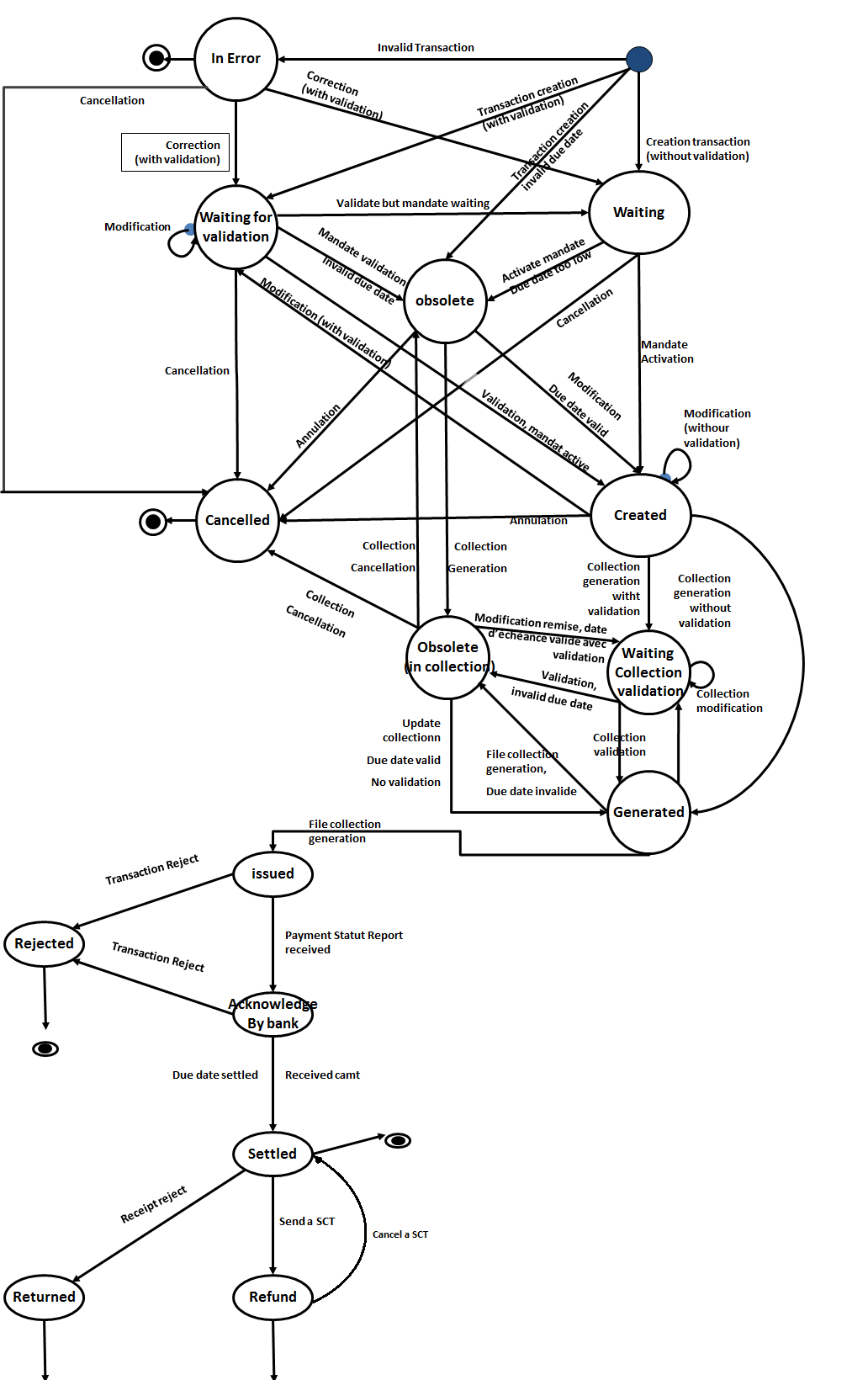SDDs see their status change throughout their lifecycle. The following diagram provides a summary of the SDD flow lifecycle. It assumes that the double validation of transactions and collections is active:

Figure 21 - SDD lifecycle
At the time of its creation through a debit application approved by SEPA Payment Suite or through a generation according to a payment schedule, the SDD status is subject to consistency checks. The resulting statuses are:
“Error” if the data in the debit application is incorrect or if the mandate status is “Finalised”, “Invalidated” or “Revoked”;
“Waiting for validation” if the double validation of debits is activated;
“Waiting” if the mandate is in another intermediate status (“pending”, “Waiting for validation”, “Suspended”, ”Waiting for Reachability”).
“Obsolete” if the due date is invalid
“Created” if the mandate status is “Active”.
“Refund” status can be declined in 3 values : Refund, Partially refund, Over refund when using refund functionality on the GUI.
A SDD with a “Waiting” status switches to “Created” when the related mandate becomes “Active”. Conversely, an SDD with a “Created” status switches to “Waiting” when the related mandate is not Active (in the case of a suspended mandate, for example). In addition to this, a SDD with a “Created “or a “Waiting” status switches to “Cancelled” when the related mandate is Cancelled (in the case of a finalized or revoked mandate, for example).
A SDD can get out of “Error” status following its recycling or manual correction.
A SDD with “Obsolete” status switches to “Waiting for Validation” if it is modified and the double validation of transactions is activated, “Created” otherwise.
A SDD with “Created” status switches to “Waiting for Validation” if it is modified and the double validation of transactions is activated. The input status for a validated SDD depends on the status of the mandate to which it relates: “Waiting” if the mandate is in an intermediate status and “Created” if the mandate is active.
Only SDDs with a “Created” status are eligible for transmission to the creditor’s bank. Once included in a collection, the status of SDDs runs parallel to the status of said collection: they move to “Waiting collection validation” status if the double validation for collections is activated, or otherwise to “Generated” status. When SDDs are integrated into collection files, their statuses change to “Issued.”
At the creation time, the field Value Date is filled with the content of the Due Date entered by the client. If SPS will receive an associated R-Transaction from the creditor bank that specifies a different Value Date for the transaction, then this field is updated accordingly.
When the value date is reached, the Transaction status automatically becomes “Settled”.
If an R-Transaction that announces that the transaction was not executed due to some errors is received while the status is still “Issued”, then the new status becomes “Rejected”. In the case when the current status of the transaction is already “Settled”, the new status becomes “Returned”.
If the creditor has made a cancellation or repayment request which has been accepted by SEPA Payment Suite, and which relates to an SDD bearing “Created” or “Pending” status, the status of the latter switches to “Cancelled.” Similarly, the revocation of a mandate involves updating the status of its SDD with “Created” status to “Cancelled.”
If the creditor has made a cancellation or repayment request which has been accepted by SEPA Payment Suite, and which relates to an SDD bearing “Issued”, “Settled” or “Settled” status, the status of this latter switches to “Reversed.” Similarly, the revocation of a mandate involves updating SDDs with “Issued” or “Settled” status to “Reversed.” SDDs whose reversal is rejected by the bank go from being in “Reversed” to “Reversal rejected” status.
Finally, if the creditor makes a reversal request on an SDD settled beyond the statutory period provided by the SDD method, SEPA Payment Suite automatically generates an SCT transfer. The status of the original SDD is changed to “Refunded” or Partially refunded or over refunded depending on the amount of the reversal. This action can be configured.